Intangible Cultural Heritage
Intangible cultural heritage, also known as ‘living heritage’, refers to the practices, representations, expressions, knowledge and skills transmitted by communities from generation to generation.
It provides these communities with a sense of identity and continuity, while promoting creativity and social well-being, contributing to the management of the natural and social environment and generating income. Much of what is called traditional or indigenous knowledge is, or can be, integrated into health care, education and management of the natural resources systems.
The 2003 UNESCO Convention for the Safeguarding of the Intangible Cultural Heritage aims to safeguard this fragile heritage, secure its viability and make sure full advantage is taken of its potential for sustainable development. UNESCO’s action in this field supports Member States worldwide by promoting international cooperation for safeguarding, and by creating institutional and professional environments favorable to the sustainable safeguarding of this living heritage.









